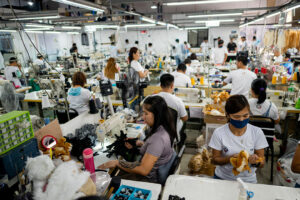




Inflation Update: Green light for easing
 DOWNLOAD
DOWNLOAD

December Economic Update: One for them, one for us
 DOWNLOAD
DOWNLOAD

Philippines Trade Update: Trade trajectories trend along
 DOWNLOAD
DOWNLOAD


Manufacturing activity expands in February

Factory activity in the Philippines expanded for the sixth straight month in February amid a strong increase in new orders that boosted hiring, but shortages in raw materials continued to affect production, S&P Global said on Friday.
The S&P Global Philippines Manufacturing Purchasing Managers’ Index (PMI) rose to 51.0 in February from 50.9 in January. A PMI reading above the 50 mark denotes improvement in operating conditions compared to the preceding month, while a reading below 50 signals deterioration.
“The start of the year was somewhat subdued for Filipino manufacturers, amid muted demand. However, in February, growth in new orders gained momentum, which in turn supported a fresh rise in employment and sustained growth in purchasing activity,” Maryam Baluch, economist at S&P Global Market Intelligence, said in a statement.
The Philippines’ February PMI reading was the second fastest among six Association of Southeast Asian Nations (ASEAN) member countries, behind Indonesia (52.7) and ahead of Vietnam (50.4).
Meanwhile, Malaysia (49.5), Myanmar (46.7), and Thailand (45.3) posted contractions in manufacturing output last month. On average, the ASEAN headline PMI picked up to 50.4 in February from 50.3 in January.
The headline PMI measures manufacturing conditions through the weighted average of five indices: new orders (30%), output (25%), employment (20%), suppliers’ delivery times (15%) and stocks of purchases (10%).
The health of the Philippine manufacturing sector was “modest overall” last month, S&P Global said in its report.
“New orders rose further as underlying demand conditions improved in February, with the rate of growth quickening from January. Additionally, the upturn in new factory orders was also supported by a renewed rise in export sales. While the rate of expansion in new export orders was fractional overall, it marked the first month since last November whereby foreign demand for Filipino manufactured goods improved,” it said.
Strong demand boosted hiring, S&P Global said, noting that February was the first time since October that workforce numbers climbed.
“Moreover, while the rate of job creation was modest overall, it was the sharpest in 16 months,” it said.
“However, while growth in new orders gained momentum, the upturn in production slowed to near-stagnation. The rate of expansion was the weakest noted in one-and-a-half years. An insufficient supply of raw materials was cited as a major hindrance for some firms,” S&P Global added, noting that this put a strain on firms’ pre- and post-production inventories.
Supply chain issues attributed to raw material shortages and poor weather resulted in longer average lead times for inputs last month, it said. This caused input costs to pick up and led firms to pass on these hikes through higher output charges.
“[The] sector was held back by the severity of material shortages. Growth in production was only fractional, with firms chipping away at their holdings of inputs and finished items to meet order requirements. These concerns also clouded sentiment, with confidence for the year ahead weakening,” Ms. Baluch said.
S&P Global said the outlook for production weakened, with the level of positive sentiment seen in February matching the October level and being the joint-lowest in 20 months.
Spending related to the Lunar New Year holiday could have contributed to the pickup in factory activity in February, Rizal Commercial Banking Corp. Chief Economist Michael L. Ricafort said in an e-mail.
“The manufacturing PMI data is still better versus the contraction mode in other countries around the world, especially in the country’s major trading partners,” he added.
Easing inflation would help support manufacturing activity this year as it could lead to lower financing costs for firms, Mr. Ricafort said.
ING Bank N.V. Manila Senior Economist Nicholas Antonio T. Mapa said in a Viber message that the sustained improvement in economic activity boosted demand, which supported firms’ production.
“Unfortunately tight supply conditions hampered the growth, although we welcome the resumption of hiring activity. The drawdown of inventories could manifest in GDP (gross domestic product) figures for the first quarter, which could be offset by increased production,” Mr. Mapa said.
However, he warned that the impact of raw material shortages on companies’ inventories could affect price prospects this year.
“It is important to establish if this uptick trend [in the PMI] will continue amid the higher-for-longer interest rate environment. We also are expecting the impact of El Niño, which is already starting to be felt domestically in various provinces,” Union Bank of the Philippines, Inc. Chief Economist Ruben Carlo O. Asuncion said in a Viber message.
The Bangko Sentral ng Pilipinas (BSP) has kept its policy rate unchanged at a 16-year high of 6.5% for three straight meetings. It hiked rates by 450 basis points between May 2022 and October 2023 to help bring down elevated inflation.
BSP Governor Eli M. Remolona, Jr. has also said the Monetary Board could consider cutting borrowing costs in the second half, but may need to keep rates tight this semester amid lingering risks to the inflation outlook.
The central bank expects inflation to average 3.6% this year and 3.2% in 2025.
In January, headline inflation eased to an over three-year low of 2.8%.
The BSP and analysts have said the consumer price index may pick up anew in the coming months due to easing base effects and El Niño risks. — Beatriz Marie D. Cruz
This article originally appeared on bworldonline.com





 By BusinessWorld
By BusinessWorld
